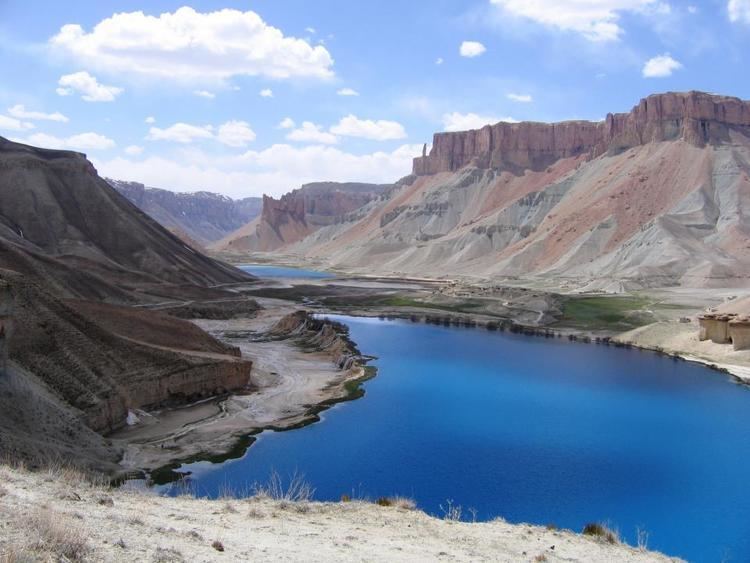Established 2009 | Address Afghanistan | |
 | ||
Governing body National System of Conservation Areas (SINAC) | ||
Band-e Amir National Park (Persian: بند امیر) is Afghanistan's first national park, located in the Bamyan Province. It is a series of six deep blue lakes separated by natural dams made of travertine, a mineral deposit. The lakes are situated in the Hindu Kush mountains of central Afghanistan at approximately 3000 m of elevation, west of the famous Buddhas of Bamiyan.
Contents
They were created by the carbon dioxide rich water oozing out of the faults and fractures to deposit calcium carbonate precipitate in the form of travertine walls that today store the water of these lakes. Band-e Amir is one of the few rare natural lakes in the world which are created by travertine systems. The site of Band-e Amir has been described as Afghanistan's Grand Canyon, and draws thousands of tourists a year. The river is part of the system of the Balkh River.
History
The name Band-e Amir literally means "Commander's Dam" which is believed by some to be a reference to Ali, the fourth Caliph of the Muslims. The area is dominated by ethnic Hazaras, who make up around 8-15% of Afghanistan's population and the most of them are followers of Shia Islam.
Band-e Amir was to become Afghanistan's first national park in the 1960s but this was delayed due to political crises and the decades of wars. Parts of the 1975 Bollywood film Dharmatma, with Feroz Khan and Hema Malini, were filmed at the Band-e Amir National Park.
In 2004, Band-e Amir was submitted for recognition as a World Heritage site. In 2009, Band-e Amir was finally declared Afghanistan's first national park. As of 2013, about 6,000 local tourists visit the Band-e Amir National Park every year. The area is protected by a small number of park rangers.
Geography
Band-e Amir is situated at approximately 75 km to the north-west of the ancient city of Bamyan, close to the town of Yakawlang. Together with Bamiyan Vally, they are the heart of Afghanistan's tourism, attracting thousands of tourists every year and from every corner of the world. The six constituent lakes of Band-e Amir are:
Band-e Haibat is the biggest and the deepest of the six, with an average depth of approximately 150 metres, as estimated by the Provincial Reconstruction Team diving team from New Zealand.
The white travertine dams created by fault lines, which are prevalent in the Band-e Amir Valley, form the barriers between the lakes.
Another comparable lake is Band-e Azhdahar (The Dragon), located a few kilometres southeast of the town of Bamyan, which has also been created as a result of carbon dioxide rich water oozing out of the faults underground and depositing calcium carbonate precipitate to form the travertine walls of Band-e Amir.
The Band-e Amir lakes are primarily a late spring and summertime tourism destination, as the high elevation central Hazarajat region of Afghanistan is extremely cold in winter, with temperatures reaching as low as -20C.
Current status
The local people in Band-e-Amir National Park rely heavily on park natural resources for the livelihood. Grazing of livestock, shrubs collection for fuel and winter fodder and rainfed farming is still widely practiced within the park boundary. Although the illegal hunting of birds and a few mammals living in the park is formally prohibited by the park office, there is no up to dated data and information to evaluate the status of wildlife and biodiversity.
After the formal establishment of the park in 2009, a park office with a park warden and a group of rangers was installed to take over management responsibilities including conservation and protection of park natural resources. Wildlife Conservation Society (WCS) is the only NGO has its office within the park and attempts to support park staff and work with local community to enhance awareness and promote conservation and sustainable use of natural resources.
Benefit from ecotourism is expected to be an alternative to decrease dependency on park natural resources. Band-e-Amir receive tourism only in summer months when the weather is warm, however it also has a great potential to attract tourism in winter. The problem is that local people remains poor and there is limited courage of outsiders to invest in this growing industry.
